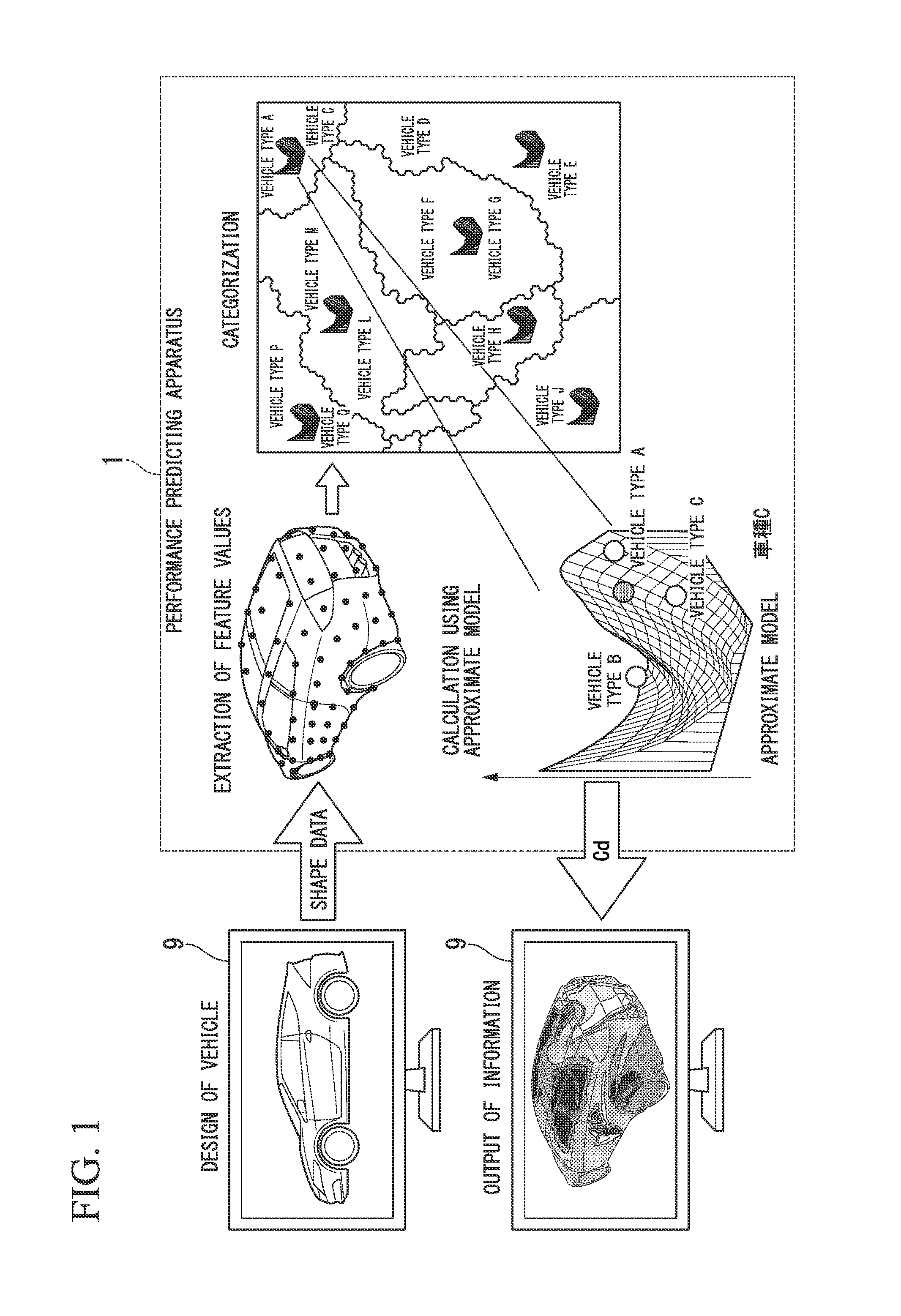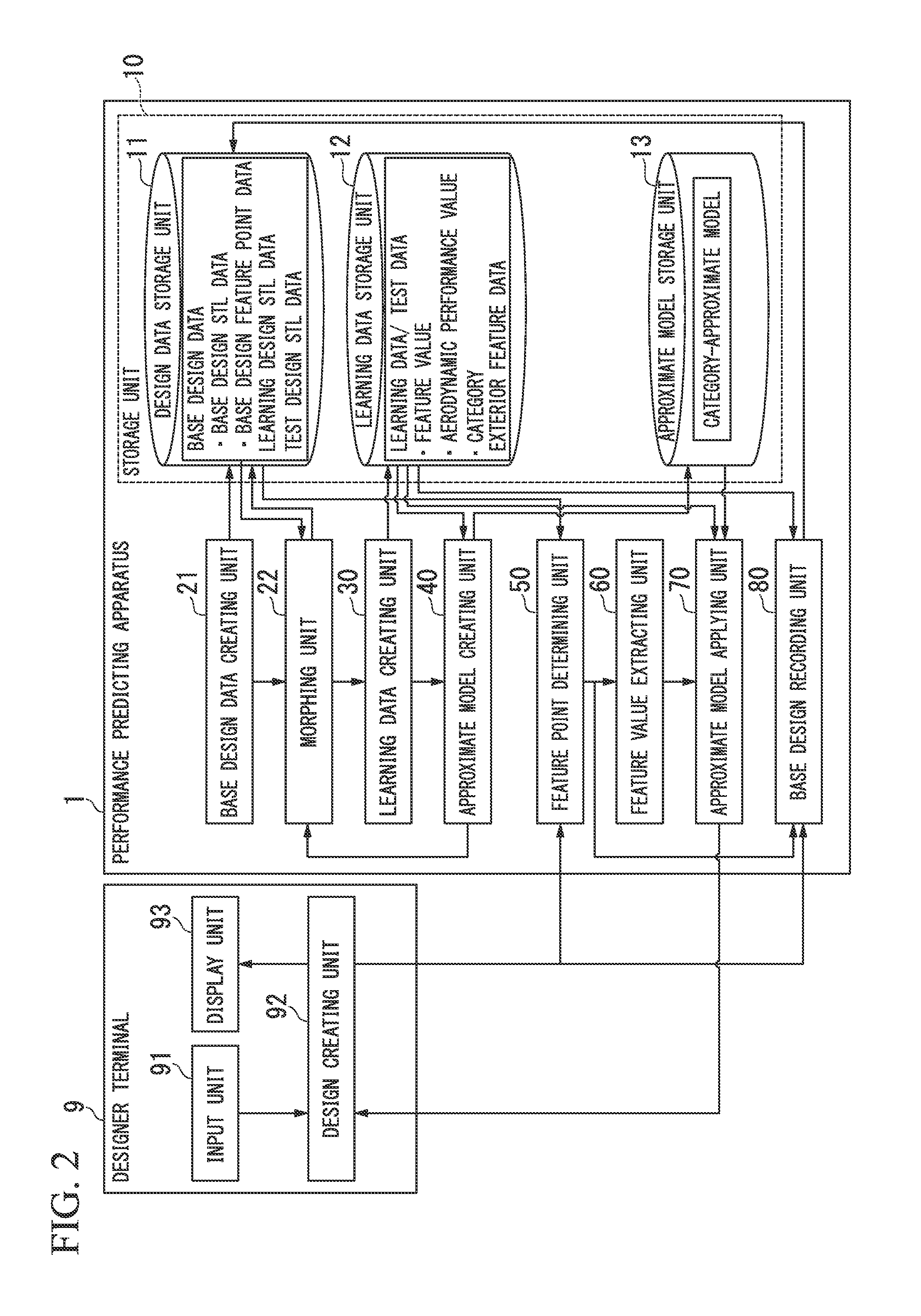Performance predicting apparatus, performance predicting method, and program
a performance prediction and performance prediction technology, applied in the field of performance prediction apparatus, can solve the problems of low prediction accuracy, inability to manually extract feature points from a large amount of design information for creating an approximate model, and inability to accurately predict functional performance. to achieve the effect of accurate prediction of functional performan
- Summary
- Abstract
- Description
- Claims
- Application Information
AI Technical Summary
Benefits of technology
Problems solved by technology
Method used
Image
Examples
first embodiment
[0094]FIG. 1 is a diagram illustrating schematic processes in a performance predicting system according to the invention. The performance predicting system can be constructed as a client-server system and includes a performance predicting apparatus 1 as a server and designer terminals 9 as a client.
[0095]In the first embodiment, an example where an object of which functional performance should be predicted is a vehicle and functional performance to be predicted is aerodynamic performance will be described. A vehicle shape and aerodynamic performance of a vehicle have a close relationship. The performance predicting apparatus 1 according to the first embodiment creates approximate models for calculating an aerodynamic value (functional performance value) from feature values acquired from a vehicle shape (object shape) for each category of a vehicle. When receiving shape data of a vehicle (hereinafter, referred to as “design vehicle”) designed by a designer using the designer terminal...
second embodiment
[0280]According to the above-mentioned second embodiment, by using a plurality of approximate models, it is possible to accurately predict the aerodynamic performance of a newly-designed vehicle.
[0281]In learning approximate models, since the feature points having an influence on the aerodynamic performance are selected through high-speed model learning and then an approximate model using only the selected feature points is created through accurate model learning, it is possible to accurately and quickly create an approximate model.
[0282]By using the approximate models using only the feature values having an influence on the aerodynamic performance, it is possible to reduce the time needed to predict the aerodynamic performance of a designed vehicle.
[0283]Since the feature points of a vehicle having a newly-created shape are determined based on the pattern matching with vehicles of which the feature points are known, it is possible to accurately extract the feature points to be used...
third embodiment
[0294]The design data storage unit 151 stores base design data, learning design ST1 (Standard Triangulated Language) data, and test STL data. The base design data includes base design STL data of a base vehicle and base design feature point data. The base vehicle is a vehicle from which a learning vehicle which is a vehicle for creating an approximate model (response surface: approximating the relationship between responses (the Cd values in the third embodiment) predicted from a plurality of feature values (design variables)) is created through morphing. The base design STL data expresses the vehicle shape of the base vehicle using STL data of a general format for expressing a three-dimensional shape. The base design feature point data represents feature points of the vehicle shape of the base vehicle. The feature points are used to extract a feature value. Examples of the feature value include a positioning coordinate of a predetermined position of a vehicle body, an angle of the ...
PUM
 Login to View More
Login to View More Abstract
Description
Claims
Application Information
 Login to View More
Login to View More - R&D
- Intellectual Property
- Life Sciences
- Materials
- Tech Scout
- Unparalleled Data Quality
- Higher Quality Content
- 60% Fewer Hallucinations
Browse by: Latest US Patents, China's latest patents, Technical Efficacy Thesaurus, Application Domain, Technology Topic, Popular Technical Reports.
© 2025 PatSnap. All rights reserved.Legal|Privacy policy|Modern Slavery Act Transparency Statement|Sitemap|About US| Contact US: help@patsnap.com



